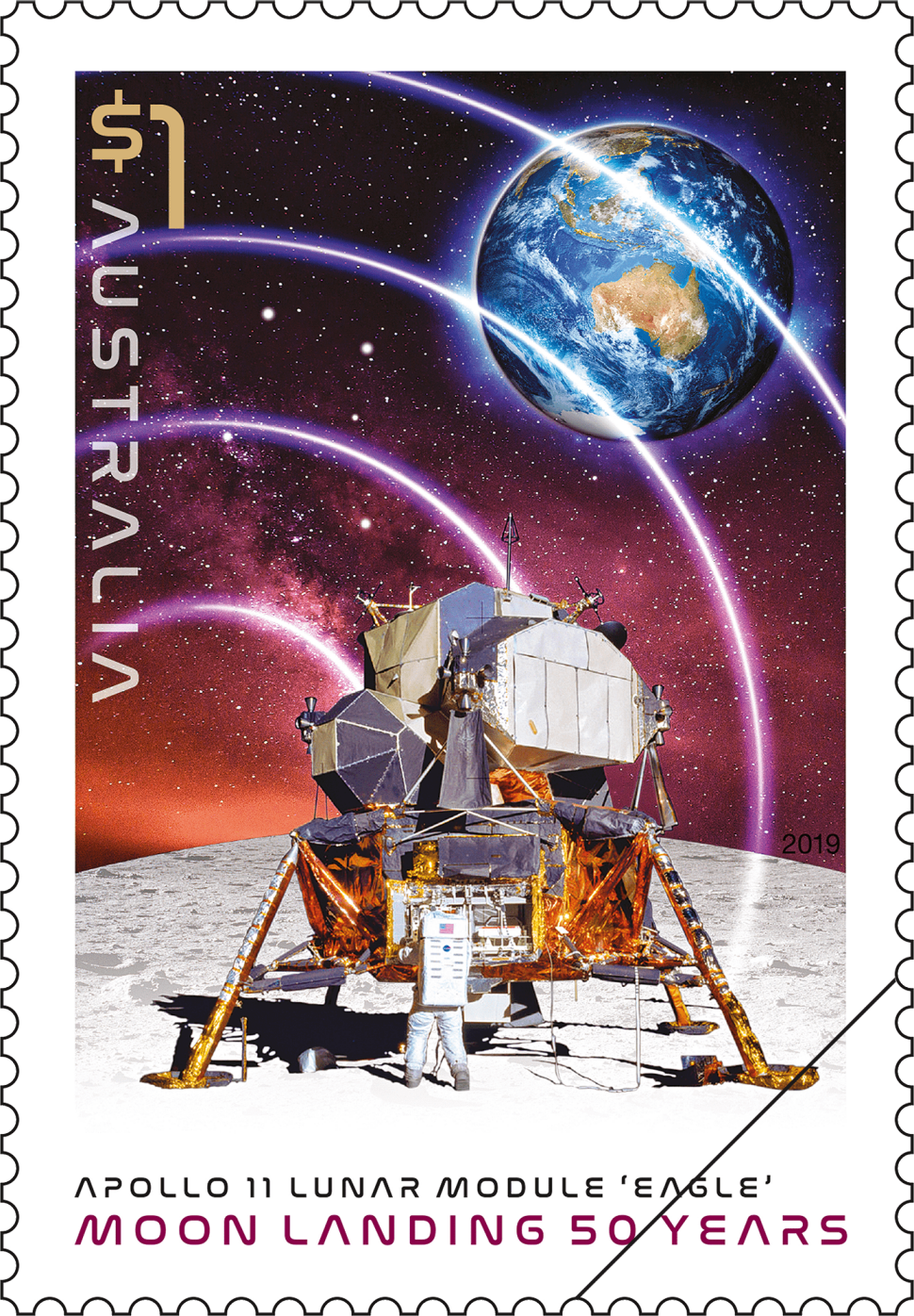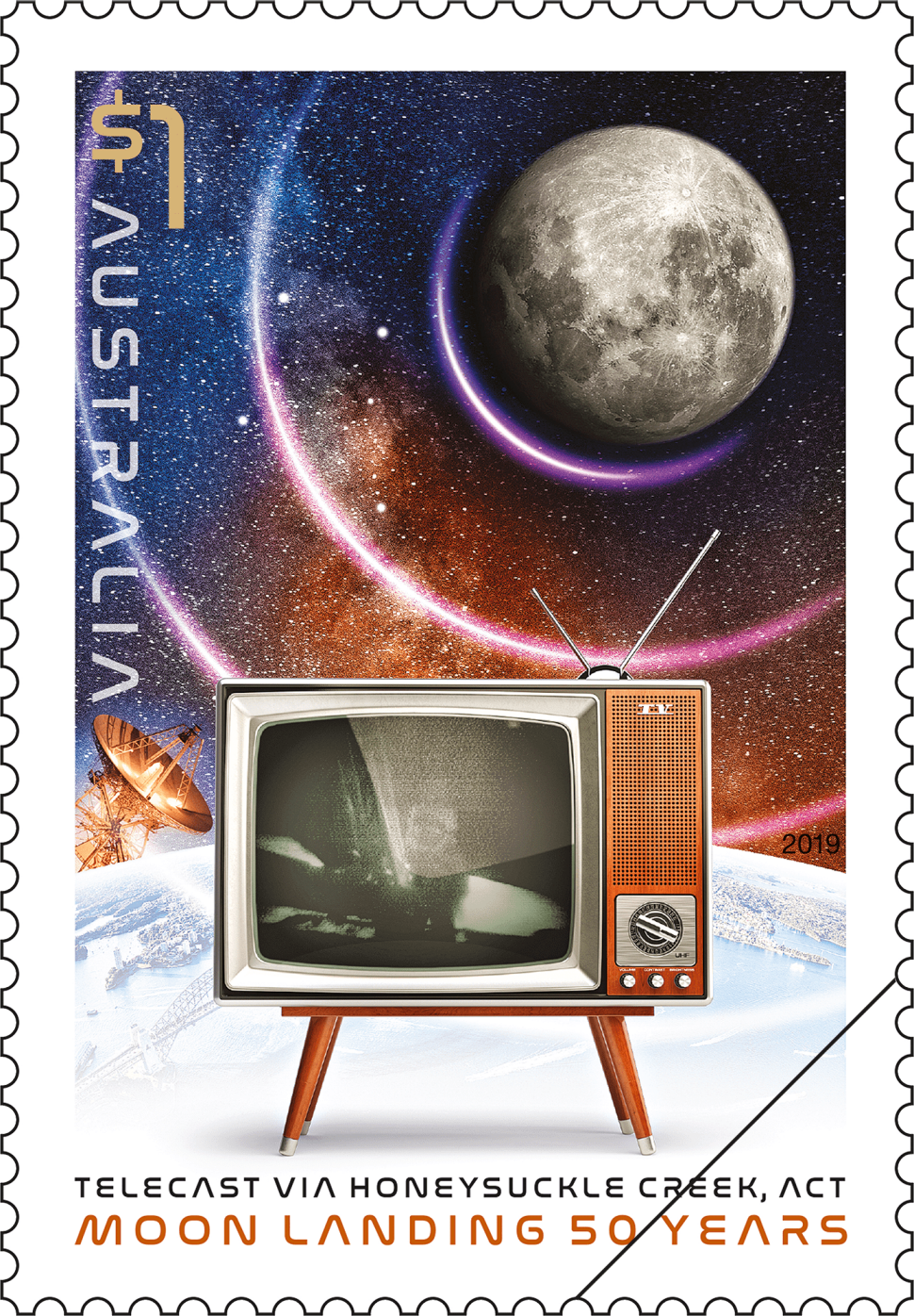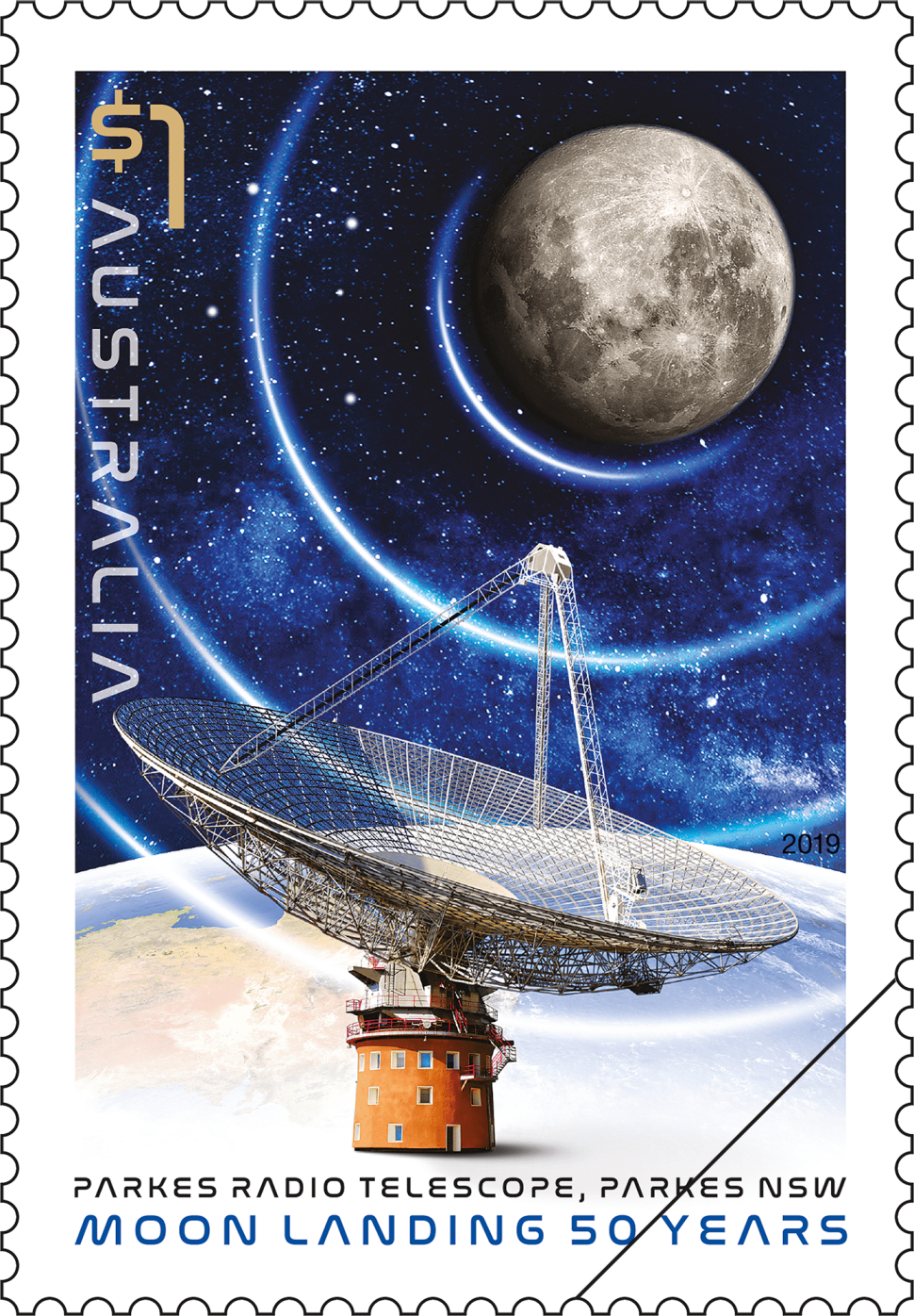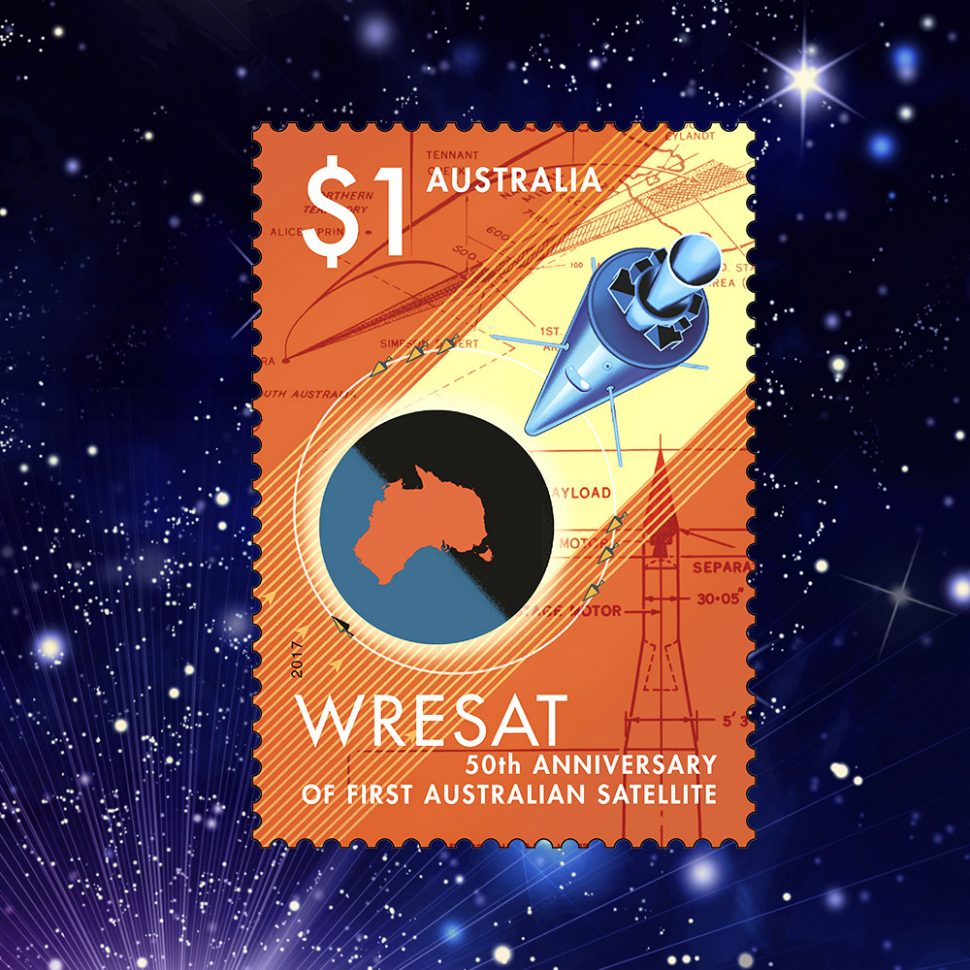One of the 20th century’s defining moments occurred 50 years ago, at 12.56 pm on 21 July 1969 (AEST), when Neil Armstrong became the first person in history to step onto the surface of the Moon.
The successful Apollo 11 mission fulfilled President John F. Kennedy’s 1961 challenge to the American nation to “land a man on the Moon” before the end of the decade. The historic event was also a victory for the United States in the Cold War “space race” between the USSR and USA. Although the Russians were the first to send a human-made object to the Moon in 1959 and in 1961 cosmonaut Yuri Gagarin became the first person to orbit Earth, Apollo 11 represented the fulfilment of the ultimate dream.
On 16 July 2019, we will release the Moon Landing: 50 Years stamp issue in recognition of this historic event. Designed by Gary Domoney of Visua, the four stamps and minisheet highlight key aspects of the Apollo 11 mission as well as Australia’s involvement in it. Products released with this issue include two postal numismatic covers, two medallion covers, and a special stamp pack that contains two limited-edition stamp sheetlets, as well as a detailed visual map of the Apollo 11 flight path.
The Apollo 11 mission
Apollo 11, as its name suggests, was the 11th spaceflight as part of NASA’s Moon exploration program. The first four flights, commencing in 1968, tested the equipment used in the Apollo program. Six of the other seven flights landed on the Moon, including the final Moon landing in 1972.
While the primary goal of Apollo 11 was to land a person on the Moon, there were other objectives, including scientific exploration, deploying a television camera to transmit signals to Earth, deploying equipment for conducting scientific experiments and photographing the lunar environment. By the end of the Apollo missions, 12 astronauts had walked on the Moon to carry out these objectives, as well as collecting rocks to bring back to Earth.
Apollo 11 was launched by a Saturn V rocket on 16 July from Kennedy Space Centre in Florida, USA. The spacecraft had three components, comprising a command module with a cabin for three astronauts (Columbia), a supporting service module and a lunar module (Eagle). The lunar module had two stages: a descent stage for landing on the Moon and an ascent stage to take the astronauts back into lunar orbit. In addition to NASA astronauts Neil Armstrong and Edwin “Buzz” Aldrin, a third astronaut, Michael Collins, was required to pilot the command module Columbia in orbit around the Moon.
The Eagle was used for descent to the lunar surface and served as a base while the astronauts were on the Moon. The Eagle alighted in the plain known as the Sea of Tranquility, Armstrong radioed back, “Houston, Tranquility Base here. The Eagle has landed”.
The first Moon walk
Nearly seven hours after landing on the Moon, Neil Armstrong climbed down the ladder of the Eagle to become the first person to step onto the lunar surface. As he alighted, Armstrong uttered the now immortal words, “That’s one small step for [a] man; one giant leap for mankind”.
Armstrong was accompanied in the Eagle by pilot Edwin “Buzz” Aldrin, who joined him soon after, and offered a simple but powerful description of the lunar surface: "magnificent desolation." They explored the surface, collecting samples and taking photographs. They left behind an American flag, a patch honouring the fallen Apollo 1 crew, and a plaque on one of Eagle's legs. It reads, "Here men from the planet Earth first set foot upon the moon. July 1969 A.D. We came in peace for all mankind." The stamp shows Armstrong’s famous photograph of Aldrin with Armstrong and the Eagle reflected in his visor.
Meanwhile, the third astronaut, Michael Collins, piloted the command module Columbia in lunar orbit. After spending a total of 21 hours 36 minutes on the lunar surface the Eagle carried the two men back to the orbiting Columbia to rejoin Collins.
A separate ascent stage, comprising the top portion of the lunar module, lifted the astronauts from the Moon's surface to rendezvous and dock with the command module, orbiting the Moon. To rejoin the command module, the astronauts fired the ascent-stage rocket engine and lifted off, leaving the descent stage on the Moon. The ascent stage met and docked with the command module in lunar orbit. The ascent stage then was programmed to crash into the Moon. After reclaiming Armstrong and Aldrin from the ascent stage of the lunar module, Columbia was the only part of the spacecraft to return to Earth. Columbia splashed down in the Pacific Ocean 25 July at 2.49 p.m. (AEST), 8 days, 3 hours, 18 minutes, 35 seconds after launching from Kennedy Space Centre, Florida.
Australia’s important role
Australia played a crucial role in telecasting the historic event to television sets all over the world, specifically to receive the signals from the Apollo 11 spacecraft when the Moon was hidden from Earth’s Northern Hemisphere.
The actual moments of Armstrong stepping onto the lunar surface were carried via the Honeysuckle Creek tracking station (ACT). After the first nine minutes the Parkes radio telescope (NSW) transmitted the rest of the broadcast, because although the Parkes antenna was more powerful for downloading, the angle of its dish was not capable of receiving a signal for the first minutes of the Moon walk. The NASA tracking stations at Carnarvon (WA) and Tidbinbilla (ACT) also supported the mission.
Honeysuckle Creek closed in December 1981 and is now heritage listed. The stamp shows the grainy black-and-white television images of Armstrong climbing down the ladder of the Eagle to take the first step on the Moon, with Honeysuckle Creek tracking station in the background.
The CSIRO Parkes radio telescope is located just outside the town of Parkes in the central-west region of New South Wales. With a diameter of 64 metres, Parkes is one of the largest single-dish telescopes in the southern hemisphere dedicated to astronomy. The telescope was officially opened on 31 October 1961.
Despite high winds, for more than two hours, the Parkes radio telescope relayed footage from the Moon. One television signal went to the Australian Broadcasting Commission, the other to Houston for the international telecast. The delay in the signal travelling from Sydney to Houston meant that Australian audiences saw the footage 0.3 seconds before the rest of the world.
To learn more about the Apollo 11 mission, visit the NASA website.
The Moon Landing: 50 Years stamp issue is available from 16 July 2019, online, at participating Post Offices and via mail order on 1800 331 794, while stocks last.
View the gallery and technical details from this issue.
This content was produced at the time of the product release dates and will not be updated.









